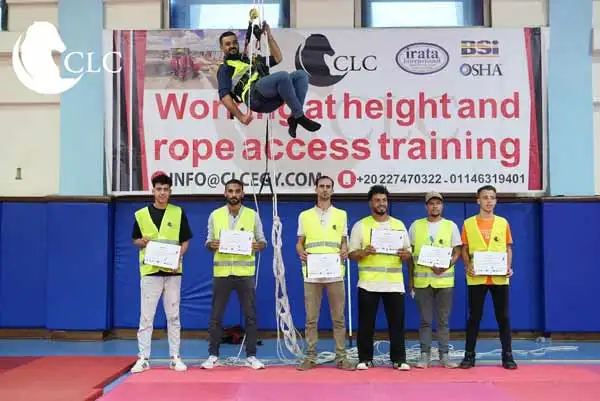
Many people turn to fall protection installation, especially Lifeline Systems, which are considered the ideal solution for ensuring worker safety at elevated sites.
These systems help reduce the risk of falls during construction and industrial projects.
Lifeline systems rely on advanced technologies that allow workers to move freely while staying protected, making them an essential choice in work environments that demand high safety standards.
In this article, we’ll provide you with all the important information you need to know about installing Lifeline fall protection systems.
Steps for Installing Lifeline Fall Protection Systems
Installation of Lifeline Fall Protection Systems requires following precise steps to ensure their effectiveness in protecting workers at heights, Below are the essential stages for safely installing Lifeline Fall Protection Systems:
Risk Assessment and Determining Installation Points
A thorough site evaluation is conducted to identify high risk areas such as:
- Unprotected edges
- Elevated surfaces
This ensures the system is placed where protection is most needed.
Choosing the Right System for the Work Environment
The appropriate type of Lifeline is selected based on the nature of the work, whether:
- Horizontal
- Vertical
- Temporary
While also considering factors like the number of users and the site’s specific requirements.
Securing Anchor Points and Adjusting the Cables
Anchor points are securely fixed to suitable structures, and then cables or ropes are laid out and tensioned according to safety specifications to ensure system stability.
System Testing and Compliance Verification
Load tests and thorough inspections are performed to verify that the system can handle the expected weights and complies with international safety standards before it is used.
Types of Lifeline Fall Protection Systems
Lifeline fall protection systems are divided into several types based on their intended use and the work environment.
The Installation of Lifeline Fall Protection Systems is provided by CLC Company, and the most notable types include:
Horizontal Lifeline Systems
Horizontal Lifeline fall protection systems are used on flat or sloped surfaces such as:
- Bridges
- Steel structures
They consist of safety cables stretched horizontally between two anchor points, allowing workers to move freely while performing their tasks.
Vertical Lifeline Systems
These Lifeline systems are designed for tasks that involve climbing or descending, such as:
- Pole climbing
- Tall ladders
They rely on a vertical cable connected to a self-retracting safety system that prevents free fall in case of imbalance.
Temporary and Mobile Lifeline Systems
Temporary and mobile Installation of Lifeline Fall Protection Systems are commonly used because they are ideal for short-term projects or sites with frequently changing conditions.
They are easy to install and relocate, making them an efficient choice in dynamic work environments.
The Importance of Lifeline Systems in Worker Safety
Lifeline systems play a vital role in creating a safer work environment and reducing fall-related injuries, which are among the most dangerous incidents workers may face at construction and maintenance sites.
That’s why CLC Company is committed to providing the best Lifeline Fall Protection Systems, along with rescue training courses for workers, Key benefits include:
- Protecting workers from falls by offering a continuous safety anchor point
- Improving compliance with international occupational safety standards
- Boosting productivity by ensuring a safe and comfortable working environment
- Reducing costs associated with workplace accidents and injuries
Components of a Lifeline Fall Protection System
Before the Installation of Lifeline Fall Protection Systems, it’s essential to understand its core components.
Each part works together to ensure worker safety at heights, with a specific role in minimizing fall risks, These components include:
- The cable or rope used in the system
- Anchorage points
- Shock absorbers and tensioners
- Safety harnesses and lanyards/hooks
Safety Standards to Follow When Installing Lifeline Systems
To ensure the effectiveness of Lifeline systems in protecting workers, it’s essential to follow a set of safety standards during the installation process.
These standards help guarantee optimal performance and minimize risks while working at heights, CLC Company is committed to complying with and providing these standards:
- Global Specifications for Lifeline Fall Protection Systems
- Worker Training on System Usage
- Emergency response actions
- Regular Inspection and Maintenance for Maximum Efficiency
Why Choose Lifeline Systems from CLC Company?

CLC Company is your trusted partner for the professional installation of Lifeline fall protection systems across various work environments.
The company offers integrated solutions that meet the highest safety and quality standards, with advantages such as:
- Utilization of the latest certified technologies and equipment
- A specialized team for installation and maintenance
- Custom solutions tailored to diverse work environments
- Worker training programs including crane operation courses
- Safety courses to minimize worker exposure to risks
Ensure the safe Installation of Lifeline Fall Protection Systems and protect your workplace with CLC Company, your ideal partner in delivering industry-leading safety solutions, Contact us today for a secure and compliant work environment.
Frequently Asked Questions
1.What is the difference between horizontal and vertical Lifeline systems?
The difference lies in the installation direction and purpose:
Horizontal Lifeline systems are installed parallel to the ground on surfaces or edges, allowing workers to move freely side to side.
Vertical Lifeline systems are mounted vertically on ladders or poles, enabling safe ascent and descent while preventing free falls.
At what height is fall protection equipment required?
According to international standards such as OSHA, fall protection gear must be worn when working at heights of 1.8 meters in construction sites and 1.2 meters in general workplaces, CLC Company provides these systems to ensure worker safety and minimize fall risks.
2.How can you protect yourself from falling?
To protect yourself from falls during work, follow these precautions:
- Wear personal protective equipment (PPE) such as a safety harness connected to a Lifeline system.
- Use fall protection systems like horizontal and vertical lines, as well as guardrails.
- Ensure anchorage points are securely fixed and test all equipment before use.
- Follow safety procedures and receive training on working safely at heights.
- Keep your work area organized and free of obstacles.


